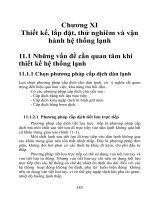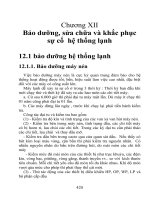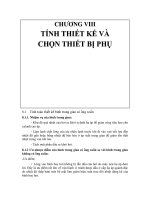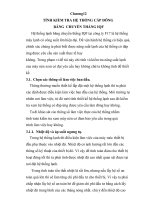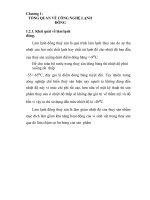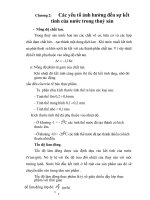hệ thống lạnh Refrigeration
Bạn đang xem bản rút gọn của tài liệu. Xem và tải ngay bản đầy đủ của tài liệu tại đây (1.49 MB, 61 trang )
Air Conditioning
Clinic
Refrigeration
System Components
One of the Fundamental Series
TRG-TRC005-EN
Perforatio
n 0.75”
from edge
Comment Card
We want to ensure that our educational materials meet your ever-changing resource development needs.
Please take a moment to comment on the effectiveness of this Air Conditioning Clinic.
Refrigeration System
Components
Level of detail (circle one)
One of the Fundamental Series
Rate this clinic from 1–Needs Improvement to 10–Excellent…
TRG-TRC005-EN
Content
1
2
3
4
5
6
7
8
9
10
Booklet usefulness
1
2
3
4
5
6
7
8
9
10
Slides/illustrations
1
2
3
4
5
6
7
8
9
10
Presenter’s ability
1
2
3
4
5
6
7
8
9
10
Training environment
1
2
3
4
5
6
7
8
9
10
Too basic
Just right
Too difficult
Other comments?_________________________________________________________
_______________________________________________________________________________
_______________________________________________________________________________
About me … Type of business
Job function
Optional:name
phone
address
_________________________________________________________
_________________________________________________________
_________________________________________________________
_________________________________________________________
_________________________________________________________
Give the completed card to the
presenter or drop it in the mail.
Thank you!
The Trane Company • Worldwide Applied Systems Group
3600 Pammel Creek Road • La Crosse, WI 54601-7599
www.trane.com
An American-Standard Company
Perforatio
n 5.5”
from
bottom/to
p
Response Card
We offer a variety of HVAC-related educational materials and technical references, as well as software tools
that simplify system design/analysis and equipment selection. To receive information about any of these
items, just complete this postage-paid card and drop it in the mail.
Education materials
Software tools
Periodicals
t Air Conditioning Clinic series
t Engineered Systems Clinic series
t Trane Air Conditioning Manual
t Trane Systems Manual
t Equipment Selection
t System design & analysis
t Engineers Newsletter
t _____________________________
Other?
About me…
Name
___________________________________________
Title
___________________________________________
Business type ___________________________________________
Phone/fax
_____________________
____________________
E-mail address ___________________________________________
Company
___________________________________________
Address
___________________________________________
___________________________________________
___________________________________________
Thank you for your interest!
The Trane Company • Worldwide Applied Systems Group
3600 Pammel Creek Road • La Crosse, WI 54601-7599
www.trane.com
An American-Standard Company
NO POSTAGE
NECESSARY
IF MAILED
IN THE
UNITED STATES
BUSINESS REPLY MAIL
FIRST-CLASS MAIL
PERMIT NO. 11
LA CROSSE, WI
POSTAGE WILL BE PAID BY ADDRESSEE
THE TRANE COMPANY
Attn: Applications Engineering
3600 Pammel Creek Road
La Crosse WI 54601-9985
Crop to
width of
7.75”
NO POSTAGE
NECESSARY
IF MAILED
IN THE
UNITED STATES
BUSINESS REPLY MAIL
FIRST-CLASS MAIL
PERMIT NO. 11
POSTAGE WILL BE PAID BY ADDRESSEE
THE TRANE COMPANY
Attn: Applications Engineering
3600 Pammel Creek Road
La Crosse WI 54601-9985
LA CROSSE, WI
Refrigeration
System Components
One of the Fundamental Series
A publication of
The Trane Company—
Worldwide Applied Systems Group
Preface
Refrigeration
System Components
A Trane Air Conditioning Clinic
Figure 1
The Trane Company believes that it is incumbent on manufacturers to serve the
industry by regularly disseminating information gathered through laboratory
research, testing programs, and field experience.
The Trane Air Conditioning Clinic series is one means of knowledge-sharing. It
is intended to acquaint a nontechnical audience with various fundamental
aspects of heating, ventilating and air conditioning. We have taken special care
to make the clinic as uncommercial and straightforward as possible.
Illustrations of Trane products only appear in cases where they help convey the
message contained in the accompanying text.
This particular clinic introduces the reader to the concept of vapor-compression
refrigeration system components.
ii
© 1999 American Standard Inc. All rights reserved
TRG-TRC005-EN
Contents
Introduction ........................................................... 1
period one
Refrigeration Cycle .............................................. 2
period two
Condensers ............................................................ 5
Air-Cooled Condensers .............................................. 5
Evaporative Condensers ............................................ 7
Water-Cooled Condensers ......................................... 8
Condenser Control ................................................... 10
period three Evaporators .......................................................... 16
Finned-Tube Evaporators ......................................... 16
Shell-and-Tube Evaporators ...................................... 19
Evaporator Control ................................................... 20
period four
Expansion Devices ............................................. 26
period five
Accessories .......................................................... 34
Solenoid Valve .......................................................... 34
Liquid-Line Filter Drier .............................................. 36
Moisture-Indicating Sight Glass ............................... 38
Suction Line Filter .................................................... 39
Hot Gas Muffler ....................................................... 40
Shutoff Valve ............................................................ 41
Access Port .............................................................. 42
period six
Review ................................................................... 43
Quiz ......................................................................... 48
Answers ................................................................ 50
Glossary ................................................................ 51
TRG-TRC005-EN
iii
iv
TRG-TRC005-EN
Introduction
notes
Vapor-Compression Refrigeration
condenser
expansion
device
compressor
evaporator
Figure 2
The major components of a vapor-compression refrigeration system include
the compressor, condenser, expansion device, and evaporator. The latter three
will be discussed in this clinic—the compressor is discussed in a separate
clinic.
This clinic will also discuss many of the common accessories used in a comfortcooling refrigeration system.
TRG-TRC005-EN
1
period one
Refrigeration Cycle
notes
Refrigeration
System Components
period one
Refrigeration Cycle
Figure 3
First, a brief review of the vapor-compression refrigeration cycle will help to
relate these components.
Refrigeration Cycle
pressure
A
evaporator
B
enthalpy
Figure 4
A diagram of a typical vapor-compression refrigeration cycle can be
superimposed on a pressure-enthalpy (P-h) chart to demonstrate the function
of each component in the system. The pressure-enthalpy chart plots the
properties of a refrigerant—refrigerant pressure (vertical axis) versus enthalpy
(horizontal axis). Enthalpy is a measure of the heat content, both sensible and
latent, per pound [kg] of refrigerant.
The cycle starts with a cool, low-pressure mixture of liquid and vapor
refrigerant entering the evaporator (A) where it absorbs heat from the relatively
warm air, water, or other fluid that is being cooled. This transfer of heat boils
the liquid refrigerant in the evaporator, and this superheated refrigerant vapor
is drawn to the compressor (B).
2
TRG-TRC005-EN
period one
Refrigeration Cycle
notes
Refrigeration Cycle
C
pressure
compressor
A
evaporator
B
enthalpy
Figure 5
The compressor draws in the superheated refrigerant vapor (B) and
compresses it to a pressure and temperature (C) high enough that it can reject
heat to another fluid. This hot, high-pressure refrigerant vapor then travels to
the condenser.
Refrigeration Cycle
D
condenser
C
pressure
compressor
A
evaporator
B
enthalpy
Figure 6
Within the condenser, heat is transferred from the hot refrigerant vapor to
relatively cool ambient air or cooling water. This reduction in the heat content
of the refrigerant vapor causes it to desuperheat, condense into liquid, and
further subcool before leaving the condenser (D) for the expansion device.
TRG-TRC005-EN
3
period one
Refrigeration Cycle
notes
Refrigeration Cycle
D
condenser
C
pressureexpansion
device
A
compressor
evaporator
B
enthalpy
Figure 7
Finally, the high-pressure liquid refrigerant (D) flows through the expansion
device, causing a large pressure drop that reduces the pressure of the
refrigerant to that of the evaporator. This pressure reduction causes a small
portion of the liquid to boil off, or flash, cooling the remaining refrigerant to the
desired evaporator temperature.
The cooled mixture of liquid and vapor refrigerant then enters the evaporator
(A) to repeat the cycle.
4
TRG-TRC005-EN
period two
Condensers
notes
Refrigeration
System Components
period two
Condensers
Figure 8
The first major component to be discussed is the condenser. The condenser is
a heat exchanger that rejects heat from the refrigerant to air, water, or some
other fluid.
The three common types of condensers are air-cooled, water-cooled, and
evaporative.
Air-Cooled Condenser
propeller
fan
outdoor
air
condenser
coil
subcooler
Figure 9
Air-Cooled Condensers
A typical air-cooled condenser uses propeller-type fans to draw outdoor air
over a finned-tube heat transfer surface. The temperature difference between
the hot refrigerant vapor that is flowing through the tubes and the cooler
outdoor air induces heat transfer. The resulting reduction in the heat content of
the refrigerant vapor causes it to condense into liquid. Within the final few
lengths of condenser tubing (the subcooler), the liquid refrigerant is further
cooled below the temperature at which it was condensed.
TRG-TRC005-EN
5
period two
Condensers
notes
The air-cooled condenser is very popular in both residential and commercial
applications because of its convenience. It requires very little maintenance and
does not require the freeze protection and water treatment that is necessary
with a water-cooled condenser. Additionally, it is favored in areas that have an
inadequate or costly water supply, or where the use of water for air
conditioning is restricted.
Effect of Subcooling
subcooling
D
pressure
{
C
DI
AI
B
A
refrigeration
effect
enthalpy
Figure 10
The benefit of subcooling on system performance can be demonstrated by
comparing the performance of a system with and without subcooling.
The change in enthalpy (the line from A to B) that occurs in the evaporator is
called the refrigeration effect. This is the amount of heat that each pound
[kg] of liquid refrigerant will absorb when it evaporates.
In comparison, the same system without subcooling produces less refrigeration
effect (the line from A’ to B). The system without subcooling must evaporate
substantially more refrigerant within a larger coil to produce the same capacity
as the system with subcooling.
Instead of subcooling in the condenser, some packaged refrigeration
equipment, such as water chillers, may use an economizer or liquid/vapor
separator to increase this refrigeration effect.
6
TRG-TRC005-EN
period two
Condensers
notes
Centrifugal Fan Air-Cooled Condenser
condenser
coil
centrifugal
fan
Figure 11
An alternative air-cooled condenser uses a centrifugal fan to draw or blow air
over the condensing coil. The principal advantage of this design is that the
centrifugal fan is capable of overcoming the higher static-pressure losses
associated with ductwork. Therefore, if the condenser is to be located indoors
and uses a duct system to deliver air to and from the condenser coil, the
centrifugal fan air-cooled condenser is probably best suited for this
application.
Evaporative Condenser
fan
refrigerant
vapor
condenser
coil
pump
sump
liquid refrigerant
subcooler
Figure 12
Evaporative Condensers
A modification of the air-cooled condenser is the evaporative condenser.
Within this device, the refrigerant flows through tubes and air is drawn or
blown over the tubes by a fan. The difference is that water is sprayed on the
tube surfaces. As the air passes over the coil, it causes a small portion of the
water to evaporate. This evaporation process absorbs heat from the coil,
TRG-TRC005-EN
7
period two
Condensers
notes
causing the refrigerant vapor within the tubes to condense. The remaining
water then falls to the sump to be recirculated and used again.
Subcooling of the refrigerant can be accomplished by piping the condensed
liquid back through another few rows of coil tubing, located either in the
condenser airstream or in the water sump, where additional heat transfer
reduces the temperature of the liquid refrigerant.
Water-Cooled Condenser
hot, refrigerant vapor
95ºF
[35ºC]
cooling water
85ºF
[29ºC]
subcooled, liquid
refrigerant
subcooler
Figure 13
Water-Cooled Condensers
The shell-and-tube is the most common type of water-cooled condenser.
With this design, water is pumped through the tubes while the refrigerant vapor
fills the shell space surrounding the tubes. As heat is transferred from the
refrigerant to the water, the refrigerant vapor condenses on the tube surfaces.
The condensed liquid refrigerant then falls to the bottom of the shell, where it
flows through an enclosure that contains additional tubes (the subcooler). More
heat is transferred from the liquid refrigerant to the water inside these tubes,
subcooling the refrigerant.
After the warm water leaves the condenser, it must either be disposed of (as in
the case of using water from a well) or it must be cooled before it can be reused
by the condenser. In this example, the condenser brings in 85°F [29°C] water
and warms it up to 95°F [35°C]. Before this water can be used again, it must be
cooled back down to 85°F [29°C].
8
TRG-TRC005-EN
period two
Condensers
notes
Cooling Tower
propeller
fan
sprays
fill
outdoor
air
sump
85ºF
[29ºC]
to
condenser
from
condenser
95ºF
[35ºC]
Figure 14
A cooling tower is a device commonly used to cool condensing water. In this
design, warm water is sprayed over the fill inside the cooling tower while a
propeller fan draws outdoor air upward through the fill. The movement of air
through the spray causes some of the water to evaporate, a process that cools
the remaining water. This cooled water then falls to the tower sump to be
returned to the condenser.
The final temperature of the water leaving the tower is determined, in part, by
the humidity of the outdoor air. If the outdoor air is dry, the final water
temperature can be considerably lower than the ambient dry-bulb temperature.
If the outdoor air is humid, however, the final temperature will be near the
ambient dry-bulb temperature.
While a cooling tower can reclaim much of the condensing water, it cannot
reclaim it all. The evaporation process uses up water to dissipate heat
contributed by the cooling load plus the heat of compression. In addition, as the
water evaporates, the dissolved minerals and water treatment chemicals
become concentrated in the sump. To prevent this solution from becoming
concentrated and possibly corrosive, water is periodically bled from the sump
and an equal amount of fresh water is added.
In the past, some water-cooled condensers used water from either a municipal
or a natural water supply as the condensing water. After rejecting the
condenser heat to this water, it was dumped into the sewer or back into the
body of water. Environmental and economic restrictions have made this
method uncommon.
Finally, a geothermal well system can be used to reject the heat from the
condenser by circulating the condensing water through a series of
underground pipes . This method takes advantage of the naturally-cool ground
temperatures.
TRG-TRC005-EN
9
period two
Condensers
notes
Condenser Control
I
Condenser capacity is influenced by:
K Temperature
difference
between refrigerant and
cooling media
K Flow
rate of cooling media through condenser
K Flow
rate of refrigerant through condenser
Figure 15
Condenser Control
The heat rejection capacity of a condenser is influenced by (1) the temperature
difference between the refrigerant and the cooling media (air, water, or other
fluid), (2) the flow rate of the cooling media through the condenser, and (3) the
flow rate of the refrigerant through the condenser.
To balance the rate of heat rejection (in the condenser) with the changing
system load, at least one of these variables may be controlled.
Condenser Capacity
full load
condenser heat
rejection capacity
full load
pressure
part load
part load
condenser heat
rejection capacity
enthalpy
Figure 16
As the system load decreases, the heat rejection capacity of the condenser is
greater than the load. Because of this excess capacity, the condenser matches
the decreasing load by operating at progressively lower pressures. Additionally,
a reduction in outdoor air temperature allows the temperature of the air or
water flowing through the condenser to drop. This also has the effect of
lowering the condensing pressure.
10
TRG-TRC005-EN
period two
Condensers
notes
A reduction in condensing pressure lessens the power required to compress
the refrigerant. Unfortunately, if the condensing pressure falls too low, the
expansion valve may not be able to produce the flow of liquid refrigerant
needed to satisfy the demand at the evaporator. In some systems, as the
condensing pressure drops, the compressor suction pressure also drops,
resulting in evaporator frosting and possible compressor shutdown due to a
low-pressure safety device.
While it is not essential to control condensing pressure to a constant value,
provisions should be made to control it within acceptable limits.
Condensing Temperature Control
flow-regulating
valve
condenser
condenser
water pump
Figure 17
One common method of controlling the capacity of a water-cooled condenser is
to vary the rate at which water flows through the condenser.
For example, assume a water-cooled condenser is piped to a municipal water
system. To control the capacity of the condenser, a flow-regulating valve is
installed on the leaving-water side of the condenser. As the load on the system
decreases, the regulating valve senses the lowering condensing pressure. The
valve reduces the flow rate of the water until the heat-rejection rate of the
condenser balances the system load at an acceptable pressure and
temperature.
TRG-TRC005-EN
11
period two
Condensers
notes
Vary Condenser Water Flow Rate
cooling tower
cooling tower
condenser
variable-speed
drive
diverting
valve
bypass pipe
condenser
Figure 18
It is more common, however, for a water-cooled condenser to be connected to a
cooling tower.
In this case, typical methods for modulating the water flow through the
condenser include either using a variable-speed drive on the condenser water
pump or using a diverting valve and pipe to bypass the condenser. The
variable-speed drive on the pump modulates the amount of water pumped
through the condenser. The diverting valve modulates the water flow through
the condenser bundle by diverting some of the cooling water around the
condenser through the bypass pipe, directly back to the cooling tower.
Each of these options has the effect of varying the flow rate of water through
the condenser, ensuring an acceptable condensing pressure and temperature.
Vary Entering Water Temperature
variablespeed
drive
cooling tower
cooling tower
condenser
bypass pipe
diverting
valve
condenser
Figure 19
Another method of controlling the capacity of a water-cooled condenser is to
vary the temperature of the water entering the condenser.
12
TRG-TRC005-EN
period two
Condensers
notes
Common methods of modulating this water temperature include controlling the
cooling tower fans or using a cooling-tower bypass pipe. Controlling the
cooling tower fans, either by cycling fans on and off or by using a variablespeed drive on the fans, allows the system to control the temperature of the
water leaving the tower sump. The diverting valve on the cooling-tower bypass
pipe diverts warmer water leaving the condenser and mixes it with cooler water
from the cooling tower to modulate the temperature of the water entering the
condenser.
Each of these options has the effect of varying the temperature of the water
entering the condenser, ensuring an acceptable condensing pressure and
temperature.
Cooling Tower Bypass
40ºF
[4ºC]
cooling tower
bypass pipe
55ºF
diverting
valve
65ºF
[13ºC]
[18ºC]
condenser
Figure 20
Another example is a system that must start and operate during cooler weather.
The cold tower water would force the condensing pressure down to the point
where the system could not operate. In this example, the temperature of the
water entering the condenser is controlled by a diverting valve and a coolingtower bypass pipe.
If the entering water temperature causes the condensing pressure to become
too low, the valve begins to divert the warm water that is leaving the condenser
and mixes it with the cool tower water, producing a controlled water
temperature entering the condenser. In this example, by diverting 65°F [18°C]
water leaving the condenser and mixing it with the 40°F [4°C] tower water, the
condenser is provided with 55°F [13°C] condensing water. This warmer
condensing water results in a higher condensing pressure.
TRG-TRC005-EN
13
period two
Condensers
notes
Air-Cooled Condenser Control
damper
A
B
condenser
airflow
fan A
fan B
fan A
heat rejection capacity
Figure 21
A common method of controlling the capacity of an air-cooled condenser is to
vary the airflow across the condenser coil. The heat-rejection rate of a multiplefan condenser is often controlled by cycling fans on and off to maintain
acceptable condensing pressures. Alternatively, the airflow across the coil can
be varied by using a damper or a variable-speed drive on one or more of the
fans.
In this example, a damper has been added to one of the two condenser fans.
Capacity control is accomplished by cycling fan B on and off while varying the
airflow of fan A by modulating the damper. Both the damper and the cycled fan
are controlled by condensing pressure. As the heat-rejection requirement
increases, fan A continues to open its damper farther to increase its airflow.
When fan A reaches full airflow, fan B turns on and fan A modulates its damper
to continue to match the desired heat rejection rate.
Condenser Flooding Control
condenser
B
C
A
expansion
valve
liquid receiver
evaporator
discharge line
compressor
Figure 22
Another, less common method of controlling the capacity of an air-cooled
14
TRG-TRC005-EN
period two
Condensers
notes
condenser is to flood the condenser coil with liquid refrigerant. A condenser
coil tube that is filled with liquid refrigerant no longer acts as a condensing
surface. Progressive flooding of the condenser coil tubes reduces the capacity
of the condenser and raises the condensing pressure.
During normal, warm ambient conditions, valves B and C are open and valve A
is closed. Assume that the system load is falling and, at the same time, the
outdoor air temperatures has fallen to the point where the rate of heat rejection
from the condenser balances the load at a condensing pressure less than
desired. This minimum condensing pressure is the set point for valve A. As the
condensing pressure decreases, so does the pressure in the discharge line.
Valve B acts as a pressure regulator, and when the discharge-line pressure falls
below its set point, valve B closes.
This causes the condensing pressure to drop farther. Sensing this reduction in
condensing pressure, valve A opens and directs hot, high-pressure refrigerant
vapor into the receiver. This increases the pressure in the receiver, controlling it
to the desired condensing pressure. Because the pressure in the receiver is now
higher than the pressure in the condenser, the check valve C does not allow the
refrigerant to flow back into the condenser.
With valve B closed and valve A modulating to maintain the pressure in the
receiver, the pressure in the discharge line begins to increase. When it exceeds
the set point for valve B, the valve opens and again allows hot refrigerant vapor
into the condenser. However, since the condensing pressure is still below the
pressure in the receiver, the refrigerant cannot flow through valve C. This
causes the condensed liquid to remain in the condenser, where it backs up, or
floods, the condenser tubes.
The flooding of tubes causes the condenser to progressively lose capacity.
When it has flooded enough that its capacity is reduced to the point where the
condensing pressure rises above the pressure in the receiver, the higherpressure condensed liquid will flow through check valve C into the receiver.
This increases the pressure in the receiver above the minimum condensing
pressure set point, closing valve A.
Condenser coil flooding provides the capacity modulation range needed to
produce acceptable condensing pressures at reduced loads and
correspondingly-low outdoor temperatures.
TRG-TRC005-EN
15
period three
Evaporators
notes
Refrigeration
System Components
period three
Evaporators
Figure 23
The second major component to be discussed is the evaporator. The
evaporator is a heat exchanger that transfers heat from air, water, or some
other fluid to the cool liquid refrigerant.
Two common types of evaporators are the finned-tube and the shell-and-tube.
Finned-Tube Evaporator
liquid/vapor
refrigerant
airflow
refrigerant vapor
Figure 24
Finned-Tube Evaporators
A finned-tube evaporator includes rows of tubes passing through sheets of
formed fins. Cool, liquid refrigerant flows through the tubes, cooling the tube
and fin surfaces. As air passes through the coil and comes into contact with the
cold fin surfaces, heat is transferred from the air to the refrigerant. This heat
transfer causes the refrigerant to boil and leave the evaporator as vapor.
16
TRG-TRC005-EN
period three
Evaporators
notes
Turbulent Flow
Figure 25
The fins of the coil are formed to produce turbulence as the air passes through
them. This turbulence enhances heat transfer, preventing stratification within
the coil-leaving airstream.
Finned-Tube Evaporator
liquid/vapor
refrigerant
airflow
liquid
distributor
suction
header
refrigerant vapor
Figure 26
To provide uniform heat transfer throughout the coil, the liquid refrigerant is
distributed to the coil tubes in several parallel circuits. A distributor is used to
ensure uniform refrigerant distribution through these multiple coil circuits. It
distributes the liquid/vapor refrigerant mixture to the coil through several tubes
of equal length and diameter.
As the refrigerant passes through the tubes of the coil, the liquid refrigerant
absorbs heat from the air, causing it to boil off into vapor. The refrigerant vapor
leaves the coil tubes and collects in a suction header.
TRG-TRC005-EN
17
